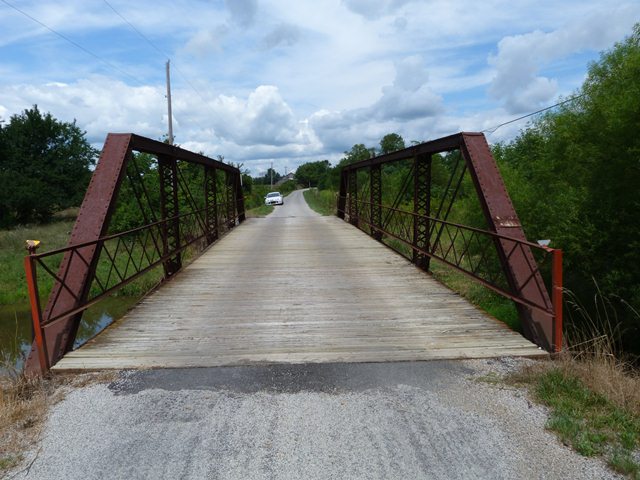We Recommend:
Bach Steel - Experts at historic truss bridge restoration.
BridgeHunter.com Phase 1 is released to the public! - Visit Now
Cardington Denmark Road Bridge

Primary Photographer(s): Nathan Holth
Bridge Documented: August 12, 2012
Rural: Morrow County, Ohio: United States
By Builder/Contractor: Virginia Bridge and Iron Company of Roanoke, Virginia
1965
60.0 Feet (18.3 Meters)
64.0 Feet (19.5 Meters)
13.5 Feet (4.11 Meters)
1 Main Span(s)
5931568

View Information About HSR Ratings
Bridge Documentation
This bridge is in storage!
Bridge Status: Replaced, but put in storage and marketed for reuse.View Archived National Bridge Inventory Report - Has Additional Details and Evaluation
This bridge has a builder plaque that is ceramic on a thin steel plate. This style of plaque is much more common in Canada than in the United States. Typical of this type of plaque, it has not held up well over the years and is nearly completely rusted away. Only the city remains, and it lists Roanoke, Virginia. Bridge builders under a couple different names operated in Roanoke. Based on the plaque type and the age/style of bridge, it is presumed that the name of the builder was Virginia Bridge and Iron Company. This builder was prolific in southern states, but is very rare in Midwestern states like Ohio. As such, this bridge is a rare example of this builder's work in this region.
Information and Findings From Ohio's Historic Bridge InventorySetting/Context The bridge carries a 1 lane, unimproved road over a stream in a rural area of active farms. Bridge posted for 4 tons. Physical Description The 1 span, 64'-long, pin-connected, half-hip Pratt pony truss bridge is supported on ashlar abutments with concrete toe walls and other repairs. The truss lines are traditionally composed with built up box sections for the upper chords and inclined end posts, and the lower chords and diagonals are eyebars. The floorbeams are salvaged. Integrity Lower chord is sprung. Summary of Significance The pin connected Pratt pony truss bridge dated stylistically to ca. 1890 is one of 20 examples of the important bridge type in Morrow County with the oldest extant example dating to 1874. Many are undocumented
and represent the era of standardization. This example, with no innovative or distinctive details, is not historically or technologically significant. A note in the county records shows that the fabricator was located in Roanoke,
VA. Metal truss bridge fabricators were located in Roanoke, VA as early as 1889 (American Bridge & Iron Co reorganized as the Virginia Bridge & Iron Co in 1895). Bridge Considered Historic By Survey: No |
![]()
Photo Galleries and Videos: Cardington Denmark Road Bridge
Bridge Photo-Documentation
Original / Full Size PhotosA collection of overview and detail photos. This gallery offers photos in the highest available resolution and file size in a touch-friendly popup viewer.
Alternatively, Browse Without Using Viewer
![]()
Bridge Photo-Documentation
Mobile Optimized PhotosA collection of overview and detail photos. This gallery features data-friendly, fast-loading photos in a touch-friendly popup viewer.
Alternatively, Browse Without Using Viewer
![]()
Southbound Crossing
Full Motion VideoStreaming video of the bridge. Also includes a higher quality downloadable video for greater clarity or offline viewing.
![]()
Maps and Links: Cardington Denmark Road Bridge
Coordinates (Latitude, Longitude):
Search For Additional Bridge Listings:
Bridgehunter.com: View listed bridges within 0.5 miles (0.8 kilometers) of this bridge.
Bridgehunter.com: View listed bridges within 10 miles (16 kilometers) of this bridge.
Additional Maps:
Google Streetview (If Available)
GeoHack (Additional Links and Coordinates)
Apple Maps (Via DuckDuckGo Search)
Apple Maps (Apple devices only)
Android: Open Location In Your Map or GPS App
Flickr Gallery (Find Nearby Photos)
Wikimedia Commons (Find Nearby Photos)
Directions Via Sygic For Android
Directions Via Sygic For iOS and Android Dolphin Browser
USGS National Map (United States Only)
Historical USGS Topo Maps (United States Only)
Historic Aerials (United States Only)
CalTopo Maps (United States Only)


